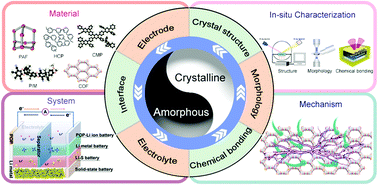Porous organic polymers for Li-chemistry-based batteries: functionalities and characterization studies
Abstract
Porous organic polymers (POPs), a versatile class of materials that possess many tunable properties such as high chemical absorptivity and ionic conductivity, are emerging candidate electrode materials, permselective membranes, ionic conductors, interfacial stabilizers and functional precursors to synthesize advanced porous carbon. Based on their crystal structure features, the emerging POPs can be classified into two subclasses: amorphous POPs (hyper cross-linked polymers, polymers with intrinsic microporosity, conjugated microporous polymers, porous aromatic frameworks, etc.) and crystalline POPs (covalent organic frameworks, etc.). This tutorial review provides a brief introduction of different types of POPs in terms of their classification and functions for tackling the remaining challenges in various types of Li-chemistry-based batteries. In situ and ex situ characterization studies are also discussed to highlight their importance and applicability for the structural investigation of POPs to reveal the underlying mechanism of POPs over the course of the electrochemical process. Although some revolutionary advances have been achieved, the development of POPs in Li-chemistry-based batteries is still in its infancy. Perspectives regarding future application and mechanistic insights of POPs in battery studies are outlined at the end.

- This article is part of the themed collection: Future Applications and Techniques using Porous Organic Polymers


 Please wait while we load your content...
Please wait while we load your content...